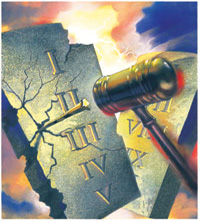Thou Shalt Not
September/October 2002With a surge toward a violent culture, many things must happen to redirect our society. I understand that simply posting the Ten Commandments will not instantly change the moral character of our nation. However, allowing states the freedom to decide these matters is an important step in promoting morality and religious freedom in our society.-REP. ROBERT ADERHOLT (R. Ala.), sponsor of the Ten Commandments Defense Act of 2002.
We'd all be better off if members of Congress started following the commandments and stopped using them for crass political purposes.-BARRY LYNN, Americans United for Separation of Church and State.

On February 6 Representative Brian Kerns introduced the Ten Commandments Public Display Resolution of 2002,1 which requires the prominent display of the Ten Commandments in the chambers of the House of Representatives and the Senate. Then in March, Representative Robert Aderholt followed suit by reintroducing his Ten Commandments Defense Act.2 This measure would empower state and local governments "to display the Ten Commandments" on public property. Representative Aderholt and others have championed such legislation since 1997, in the wake of the Judge Roy Moore controversy in Alabama.3
State Legislation
At the state level, representatives introduce Ten Commandments legislation at an even greater pace. Because of adverse court decisions, state bills focus on "historical documents" legislation. These measures call for the public display of the Ten Commandments alongside other important historical documents.
Examples include a measure in South Carolina that would allow the posting of the Ten Commandments on state-owned property, alongside the Magna Carta, the Declaration of Independence, and the U.S. Constitution.4 North Dakota passed a bill last year allowing schools to post the Ten Commandments as part of a larger display of religious and historical documents.5 Similar measures have been introduced in Alabama, Georgia, Michigan, Missouri, Mississippi, New York, Oklahoma, Pennsylvania, Tennessee, and Virginia.
Court Cases
As active as the legislative branch may be in this area, the judiciary bears the brunt of resolving the conflicts they create. Unfortunately, the U.S. Supreme Court declined to review two hotly contested cases from the state of Indiana, thus failing to provide clear answers for lower courts. O'Bannon v. Indiana Civil Liberties Union6 in 2001 and City of
The refusal by the Supreme Court to hear these cases was not without controversy. Three justices-Chief Justice William Rehnquist, Antonin Scalia, and Clarence Thomas-voted to review the Elkhart decision, and took the unconventional action of writing a dissent to the denial of review, stating that the marker "simply reflects the Ten Commandments' role in the development of the legal system."8
Split in the Lower Courts
Even as the Supreme Court declines to hear these cases, lower courts continue to issue rulings. In March a federal district court in Pennsylvania ruled in Freethought Society v. Chester County that government officials could not maintain a Ten Commandments plaque at the local courthouse, as it was found to be primarily a religious document.9 The court went so far as to count the number of words in the Ten Commandments. According to the court, "no less than 241 words are explicitly religious, while only 84 could be fairly regarding as conveying a secular, moral message." Federal judges in Nebraska and Tennessee have also recently ruled that Ten Commandments monuments must be removed from government buildings.
While most courts have struck down displays of the Decalogue, other courts disagree. In Anderson v. Salt Lake City Corporation, the Fifth Circuit upheld the constitutionality of a "passive monument" of the Ten Commandments on courthouse grounds.10 The court found that the Decalogue "has substantial secular attributes" and is "primarily secular." Also, in 1995 the Colorado Supreme Court ruled 4-3 in State of Colorado v. Freedom From Religion Foundation, Inc., that a Ten Commandments monument in a public park was constitutional.11 The majority noted that the monument was displayed in the context of many other secular symbols, representing "a cornucopia of different cultural events and experiences that make up the history of our nation and reflect upon a history that is Colorado."12
Controlling Authority
This is not to say the Supreme Court has never addressed the Ten Commandments controversy. In 1980 the High Court waded into the troubled waters with its decision in Stone v. Graham.13 The High Court struck down a Kentucky law requiring all public schools to post copies of the Ten Commandments in every classroom. The majority wrote "the preeminent purpose for posting the Ten Commandments on schoolroom walls is plainly religious in nature."14 This requires any use of the Ten Commandments to be part of the school's academic curriculum, in which students may be taught about the Decalogue. It forbids any devotional use of this portion of Scripture.
At least with regard to the disputes over the Ten Commandments in public schools, Stone v. Graham provides clear guidelines. However, when courts analyze the display of the Ten Commandments on public property outside of schools, they often look for other precedent. These courts say that Stone v. Graham is confined to the impressionable young minds of young students.
As the High Court has not definitively ruled on posting the Ten Commandments in public buildings outside of schools, lower courts must look other places for answers to this establishment clause question. For purposes of government displays of religious symbols, many courts have adopted Justice Sandra Day O'Connor's "endorsement" test, developed in her concurring opinion in the cr